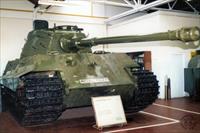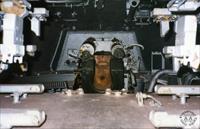MAP CONTROLS: Use slider or mousewheel to zoom, and hold down left mouse button
to drag.
KEY: Location markers are coloured from Green meaning exact to Red meaning
gone or unknown (details here)

|
|
Unique ID:
|
215
|
|
Added to Database:
|
July 2008
|
|
Last Edited:
|
22 March 2012
|
|
Type (ID):
|
Tiger II (210)
|
|
Model (ID):
|
Henschel Turret Model (400)
|
|
Location Category (ID):
|
The Tank Museum - Public Areas (3000)
|
|
Location (ID):
|
World War 2 (3010)
|
|
Serial Number: |
280093.
|
|
Registration: |
|
|
Name: |
|
|
Other Identification: |
“104” painted in grey on turret sides. German crosses painted on turret sides. Painted overall in a sand, green and brown camouflage scheme.
|
|
Collection Reference: |
E1994.81. (Accession 8194, Entry 1994.1126).
|
|
Links: |
Museum Vehicle Record
WW2 Battlefield Relics
Culture 24
Missing Lynx
YouTube 1
YouTube 2
YouTube 3
YouTube 4
|
|
References: |
|
|
Associated Tanks: |
|
Location History:
(see map) |
1: Wegmann & Co, Kassel, Nordhessen, Germany (Henschel-designed turret manufacturer)
2: Henschel und Sohn, Kassel, Nordhessen, Germany (Chassis manufacturer and vehicle assembly 1944-5)
3: Beauvais, France (Captured 1944)
4: Calais, France (Embarked)
5: Dover, Britain (Disembarked)
6: Directorate of Tank Design, Chertsey, Surrey, South East England, Britain (1945-late 1960s)
7: Defence College of Management and Technology, Shrivenham, Oxfordshire, South East England, Britain (Late 1960s – May 2006)
8: The Tank Museum - Public Areas, Bovington, Dorset, South West England, Britain (Current location)
9: The Tank Museum - Tankfest Arena, Bovington, Dorset, South West England, Britain (Static display at Tankfest June 2006)
10: The Tank Museum - Public Areas, Bovington, Dorset, South West England, Britain (Current location)
|
This King Tiger was one of the first to be encountered in France in 1944. It served with sSS-PzAbt 501 of the 1 SS PzKorps and was one of three from this unit knocked out near Beauvais (one of the others is now at the Munster Panzermuseum). It had the turret number “104” and is believed to have been knocked out by Sergeant Roberts of A Squadron, 23rd Hussars. A contemporary account states that it had disengaged from a running fight with Sherman tanks after receiving slight damage to the off-side suspension. When the driver made a sharp skid-turn in a sugar-beet field the off-side final drive smashed. All five of the crew climbed out, two of them were shot and the others surrendered. Contemporary photographs appear to show that it had a shell hole in its right hand side and it was not fitted with side-skirts.
A detachment composed of RE and REME personnel later recovered it from the field where it had sunk until it was completely bellied. It was transported to the coast by road on a Cranes heavy duty trailer designed for the British Tortoise heavy assault tank, and was then transferred from Calais to Dover on a train-ferry. It arrived at the Directorate of Tank Design (DTD), Chobham, Surrey, on 15 January 1945 and is believed to have arrived at RMCS in the late 1960s. It has an incomplete coating of Zimmerit anti-magnetic mine paste. It is currently missing its exhausts, and a pair of roadwheels at the front on its right-hand side, though it had all of these when it was recovered. It now has nearly a full complement of side-skirts; these obscure the area of the hull that appeared to have been holed.
|
November 1984
|
| | | |  | | | | |
1: The Tiger II at Shrivenham
Taken: 9 November 1984
Contributor: T. Larkum
Photo ID: 181
Added: 3 July 2008
Filename: Scan_KT_...
Views: 2035
Select/Has Priority: 1/0
|
|
|
|
|
|
|
Date Unknown
|
| | | |  | | | | |
2: An internal view of its turret
Taken: Date Unknown
Contributor: D. Brittain
Photo ID: 182
Added: 3 July 2008
Filename: Scan_KT_...
Views: 1067
Select/Has Priority: 1/0
|
| | | | | |
|
|